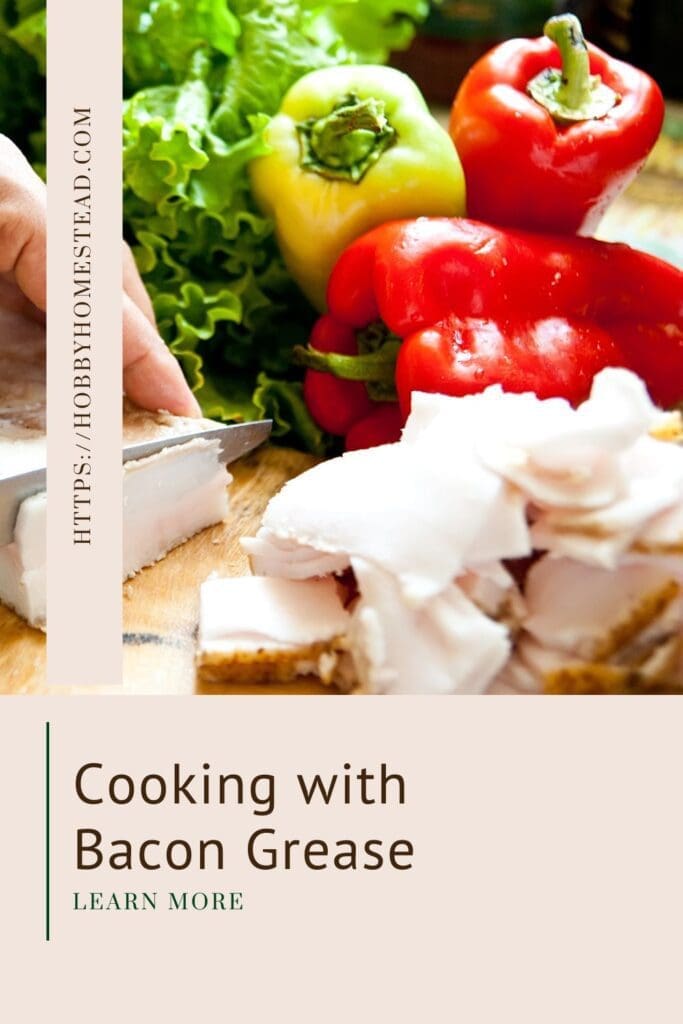Last updated on August 3rd, 2025 at 11:39 am
Whether you’re a seasoned cook or a home cook just starting to experiment, understanding how to render and cook with bacon grease can open up a whole new world of flavor. I first learned as a child how good things taste when this delicious flavor is added to so many dishes. It’s one of those versatile ingredients that can transform your cooking in delightful ways.
The great thing about this recipe is that it is budget friendly and easy to do. You’re probably cooking bacon anyway, at least on the weekends. We always had bacon lard in a container in the refrigerator when I was growing up. My refrigerator has a jar of it too. Here’s a guide on how to handle and cook with this flavorful fat.
What is Bacon Grease?
Bacon grease, often referred to as rendered bacon fat. It’s the fat rendered from cooking strips of bacon. This liquid gold is rich in flavor and can be used in various recipes to add a savory, smoky touch. When cooked properly, bacon fat, or pork fat, becomes a delicious ingredient that enhances many dishes.

How to Render Bacon Grease
- Start with the Right Bacon: Begin with thick-sliced bacon or slabs of bacon. The amount of fat you’ll render depends on the style of bacon and its fatty areas.
- Cook the Bacon: Place your bacon slices in a cold skillet or large skillet. This allows the fat to render out slowly. Use medium-low heat to cook the bacon slowly and thoroughly. The goal is to melt the fatty areas into a liquid form, leaving you with crispy bacon and bacon grease.
- Monitor the Cooking Process: As the bacon cooks, it will release its fat. Stir occasionally to ensure even cooking and to prevent burning. If you notice much fat accumulating, carefully pour some of it out into a heat-resistant container.
- Collect the Bacon Grease: Once the bacon is crispy and the fat is rendered, remove the bacon strips using a slotted spoon and place them on a paper towel to drain.
- Filter the Grease: To get rid of any solid bacon bits, pour the rendered fat through a fine-mesh strainer or a coffee filter into a glass jar or mason jar. This process ensures that you’re left with only the clean, flavorful fat. For the best results, use a piece of cheesecloth for finer filtering.
- Cool and Store: Allow the bacon grease to cool to room temperature. Once cooled, transfer it to a plastic container or glass jar with a lid. Bacon grease can be stored at room temperature for a couple of months, or in the refrigerator for a longer shelf life.
Cooking with Bacon Grease
Bacon grease is a fantastic substitute for cooking oils like vegetable oil or olive oil. Here are some great ways to use this flavorful bacon fat:
- In Place of Butter: Use bacon grease instead of butter in savory dishes like cornbread or scrambled eggs for a smoky twist. It’s a great way to add depth of flavor to your recipes.
- Frying Pan Magic: Use bacon grease in a frying pan or cast-iron pan to cook vegetables or meats. The rendered fat adds a unique taste to dishes like roasted potatoes or sautéed greens.
- Flavor Booster: Incorporate bacon grease into soups, stews, or sauces for a rich, hearty flavor. It works especially well in dishes that benefit from a touch of smoky goodness.
- In Baking: Experiment with bacon grease in baking recipes. It can be used in place of some of the fat in recipes for a unique flavor profile. Just remember, a little goes a long way!
- Freezing for Future Use: For convenience, pour leftover bacon fat into an ice cube tray or small silicone molds. Once frozen, transfer the solid cubes to a plastic container or glass jar. This makes it easy to use small amounts of bacon grease as needed.

Tips and Tricks
- Use a Heavy Skillet: For the rendering process, a heavy skillet or cast-iron pan works best. It distributes heat evenly and helps prevent the bacon fat from burning.
- Control the Temperature: Keep the heat at medium-low to avoid cooking the fat too quickly. Higher temperatures can cause the fat to burn and create a less desirable flavor.
- Be Patient: Rendering bacon fat takes time. Don’t rush the process—allow the bacon to cook slowly to extract the maximum flavor from the fat.
Bacon grease is more than just a byproduct of cooking bacon; it’s a versatile, flavorful ingredient that can elevate many dishes.
Give this a try and you’ll add a new dimension to your cooking that’s both practical and delicious. So next time you cook bacon, don’t throw away that liquid gold. Embrace it and enjoy the rich flavors it brings to your kitchen.
References
Serious Eats. How to Render Bacon Fat
Taste of the South. Render that fat! The secret to perfectly cooked bacon


